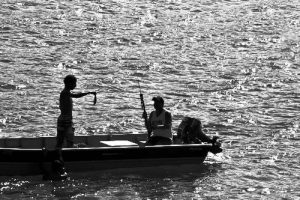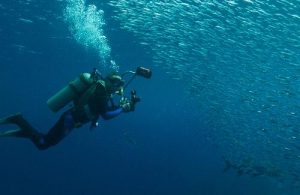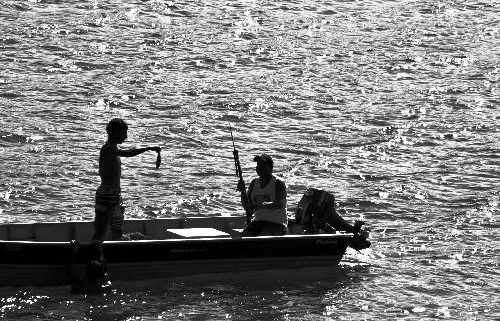The Importance of Integrating Human Activities into Marine Protected Areas
By Hannah Calich, RJD student
The benefits of marine protected areas (MPAs) have been well documented. However, since implementing them usually involves the removal or restriction of certain human activities, their implementation is often controversial. For example, MPA regulations that limit fishing can have negative socioeconomic consequences in fishing communities, which can lead to illegal, unreported, or unregulated fishing (Figure 1). To help avoid these problems managers should consider the possibility of integrating a small number of human activities into MPAs.

Fishermen illegally fishing in a protected area in Southeast Brazil. Photo credit: Rafael Guedes/Marine Photobank
Currently most MPA regulations focus on extractive uses, such as fishing, while overlooking non-extractive uses, such as scuba diving or kayaking (Figure 2). Since both extractive and non-extractive uses impact ecosystems as well as local economies, researchers have been investigating what happens when both types of uses are allowed within sections of MPAs. Specifically, researchers in Wales (UK) have used specially designed conservation software to determine the impacts of integrating extractive and non-extractive uses in MPAs (Ruiz-Frau et al., 2015). They also examined how these impacts vary depending on how a MPA is zoned. For example, do MPAs with two zones (e.g., one minimally protected zone and one highly protected zone) impact an ecosystem or economy differently than MPAs with multiple zones that have varying degrees of protection?

Scuba diving, if done responsibly, is a great example of a non-extractive way to interact with the underwater world. Photo credit: Wolcott Henry/Marine Photobank
Ruiz-Frau et al.’s (2015) results indicate that when MPAs include non-extractive uses (e.g., they allow visitors to kayak or snorkel within sections of a protected area), the negative socioeconomic impacts can be reduced by about 50% compared to when non-extractive uses are not included. Additionally, when MPAs have multiple zones they can continue to support healthy ecosystems while having a lower socioeconomic impact than MPAs with only one or two zones.
Incorporating both extractive and non-extractive uses can significantly reduce the socioeconomic impact of MPAs (Ruiz-Frau et al., 2015). These results have important implications to not only future MPAs but current ones as well. If the socioeconomic impacts of MPAs can be lowered, implementing MPAs will be less controversial and more likely to be accepted by communities, which will hopefully lead to more MPAs being developed.
Reference:
Ruiz-Frau, A., Kaiser, M. J., Edwards-Jones, G., Klein, C. J., Segan, D., & Possingham, H. P. (2015). Balancing extractive and non-extractive uses in marine conservation plans. Marine Policy, 52(2015), 11-18.




Leave a Reply
Want to join the discussion?Feel free to contribute!